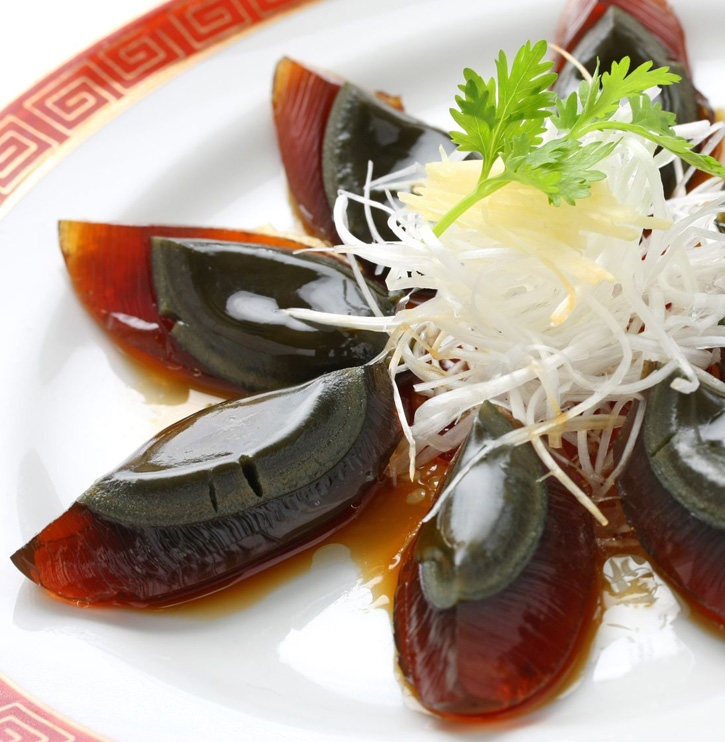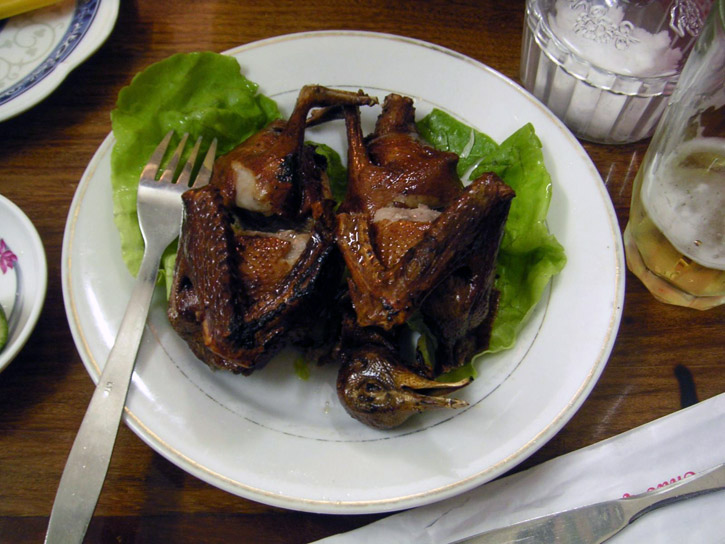In a nation as food-focused as Vietnam, it is all but impossible to come up with dozens of savory masterpieces without having created a few strange dishes along the way. While pho and banh mi (Vietnamese sandwiches) have gained worldwide acclaim as delicious, accessible facets of local cuisine, there are several specialties that manage to make some travelers wrinkle their noses.
A traditional Chinese delicacy that has carried over to Vietnam, century eggs are regular chicken or duck eggs that have been preserved in a combination of clay, ash, salt, lime, and rice for several weeks, during which time the pH of the egg elevates, changing the yolk to a dark green, creamy ball at the center of a gelatinous brown egg. The resulting dish is slightly off-putting in appearance. It’s often included in local meals and is something of an acquired taste.

Century eggs develop a dark green yolk, while the rest of the egg becomes brown and gelatinous. Photo © cokemomo/123rf.
While foreign perceptions tend to suggest that Asia is far more into dog meat than it actually is, the majority of Vietnam’s canine consumption occurs in the north, where dog is still considered something of a delicacy. Down south, you’re less likely to find locals indulging in dog, but there are still people who enjoy it every now and again, and Saigon does have a small street dedicated to the sale of canine meat. Most meals are prepared in much the same way as chicken, beef, or other meats—roasted, steamed, boiled, or barbecued—and served with rice or added into a soup.
With a government ban on the sale of dog meat and growing concerns over its safety, this delicacy may be harder to come by over the next few years. The harsh reality of this dish is that most of the animals slaughtered and prepared are actually pets or strays that have been kidnapped. Given the persistence of rabies in Vietnam, contaminated meat is a risk. Many people believe that canine meat is at its best when the animal has suffered, so the dogs are often killed in a brutal way. As demand increases throughout Southeast Asia, more and more dogs are being smuggled into Vietnam and killed, and the quality, safety, and humane treatment of these animals is fast decreasing.
Known locally as hot vit lon and more widely as balut, embryonic duck eggs are regularly consumed in Vietnam and several Southeast Asian countries, namely the Philippines. Larger and more dense than your average chicken egg, hot vit lon is consumed when the fetus is 19-21 days old—still too small to hatch but old enough that its wings, feet, beak, and eyes are visible. Like any egg, the yolk is thick and a little dry, while the tiny bird makes up the majority of the shell. Hot vit lon is commonly enjoyed on the street with salt, pepper, or lime and an ice-cold beer.
In the mountainous north where protein is scarce, small birds are often a part of local fare. Creatures like pigeons and other forest-dwelling birds are grilled and eaten with rice and rice wine or beer.

Cooked pigeons served on a bed of lettuce. Photo © ayu oshimi, licensed Creative Commons Attribution Share-Alike.
In the Mekong Delta and parts of Cambodia, rice paddy rats are a delicacy. Much cleaner than their city-dwelling counterparts, these countryside rodents are sold at the market on a seasonal basis and usually grilled, barbecued, or boiled. Dishes are best enjoyed with beer or rice wine.
Particularly in the north, snake meat is a delicacy. While some creatures are simply slaughtered and prepared like any other meal, eating snake is more often than not an almost ritualistic experience. First, the live animal is slit from neck to tail, slicing open the skin to reveal its flesh, before its blood and bile are drained into separate shot glasses and combined with rice wine. After the blood has been consumed, the snake’s still-beating heart is removed and swallowed by the guest of honor.
Excerpted from the First Edition of Moon Vietnam.